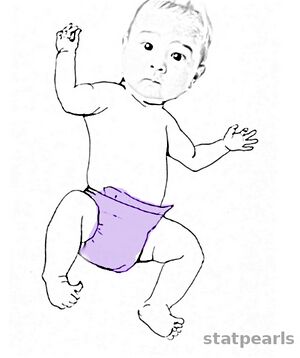Moro Reflex
Introduction[edit | edit source]
It was first described by Ernst Moro in 1918 and is a primitive infantile reflex. It is easily confused with a startle pattern or reflex. This reflex is said to be of labyrinthine origin.
Position[edit | edit source]
Head Drop Method: Supine position. Suspend the baby horizontally, in a symmetrical supine position such that the therapist's one hand behind the chest and the other supports the head. The infant's head should be in the midline position.
It is important to guarantee that both the infant's hands are open at the moment of elicitation of the reflex so as not to produce any asymmetrical response. Also, ensure that the baby is awake and not crying during the examination.
Baby Drop Method: Same as the head drop method.
Stimulus[edit | edit source]
Head Drop Method: Dropping of the head of the baby by a few centimetres.
Baby Drop Method: The therapist lowers their hands rapidly about 10 to 20 cm and brings them to an abrupt halt.
Subcutaneous Stimulus: Painful stimulus to the subcutaneous tissue of the epigastrium.( considered to be a more sensitive technique)
Response[edit | edit source]
Normal Response[edit | edit source]
Initial Phase: Abduction of the upper extremities and extension of the arms. The fingers extend, and there is a slight extension of the neck and spine.
After Phase: Arms adduct and the hands come to the front of the body before returning to the infant's side.
Abnormal Response[edit | edit source]
Diminution of the reflex within 2 to 3 months of age.
Persistence of the response beyond 6 months of age.
Asymmetrical response.
Duration[edit | edit source]
This reflex can be stimulated in all neonates during the first 12 weeks of age and disintegrates by 6 months of age.
Neural Mechanism[edit | edit source]
This reflex is primarily elicited by the vestibular nuclei. It is mediated by the brainstem and therefore its centre seems to be in the lower region of the pons to the medulla. The efferent pathways of the response seem to originate in the vestibulospinal and/or reticulospinal neurons and the reflex movement is generated by the subcortical structures without cortical participation.
The Difference between Moro and Startle Reflex[edit | edit source]
The startle reaction, the response to a sudden stimulus, is one of the defensive reactions and consists essentially of flexion movements. It differs considerably from the Moro response primarily characterized by extension.
The startle reaction induced by an auditory stimulus showed clear habituation in premature infants, whereas the Moro reflex did not, and that the startle reaction could not be elicited in anencephalic newborns, while the Moro reflex was always elicited in these infants
Clinical Significance[edit | edit source]
- The absence or premature disappearance of the Moro reflex can result from a birth injury, severe asphyxia during the birthing process, intracranial hemorrhage, infection, brain malformation, general muscular weakness of any cause, and cerebral palsy of the spastic type.
- Asymmetrical Moro can be due to a local injury.
- Damage to a peripheral nerve, cervical cord, or a fracture of the clavicle are common causes to an asymmetric Moro and causes inhibition of the reflex on the affected side.
- Prolonged retention of the Moro reflex can also be a sign of spastic cerebral palsy.
- In one study, the presence or absence of the Moro reflex is more related to the development of the infant and less likely pertains to pathogenic conditions.
- Another study showed a clear association between retained primitive reflexes and delay in motor development in very low birth weight infants.







